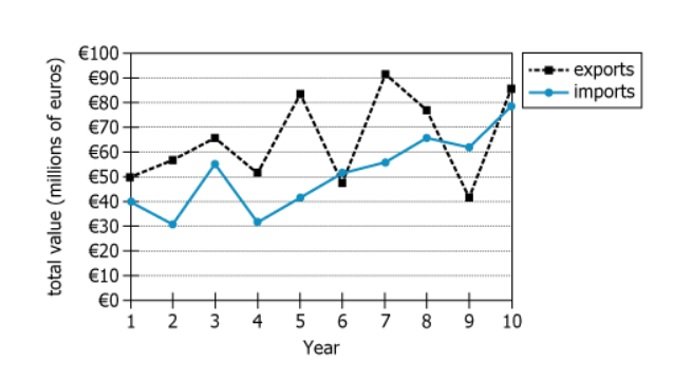The graph shows the total value of Country X's exports to Country Y and the total value of Country X's...
GMAT Graphics Interpretation : (GI) Questions

The graph shows the total value of Country X's exports to Country Y and the total value of Country X's imports from Country Y for each of 10 years.
Based on the information provided, select from each drop-down menu the option that creates the most accurate statement.
Owning The Dataset
Table 1: Text Analysis
| Text Component | Literal Content | Simple Interpretation |
|---|---|---|
| Subject Matter | total value of Country X's exports to Country Y and imports from Country Y | Examines trade flows between two countries |
| Geographic Context | Country X, Country Y | Specific but unnamed countries involved |
| Variables Tracked | exports, imports | Tracks both outgoing and incoming goods/services |
| Time Frame | for each of 10 years | Covers a decade of yearly data |
| Measurement Units | total value | Focuses on monetary worth, not quantities or types |
Table 2: Chart Analysis
| Chart Element | What is Displayed | Observations and Interpretations |
|---|---|---|
| Chart Type | Dual line graph: one series dashed (exports), one series solid (imports) | Enables direct year-by-year comparison |
| Value Range (Y-axis) | \(€10\text{ million}\) to \(€100\text{ million}\) | All data points fall within this range |
| Exports Line | Black dashed, fluctuates between \(€41\text{m}\) and \(€91\text{m}\) | Exports are more variable, with sharp increases/decreases |
| Imports Line | Blue solid, ranges from \(€30\text{m}\) to \(€79\text{m}\) | Imports are more stable, gradual changes |
| Intersecting Points | Lines cross at Year 6 and Year 9 | Only these years had imports exceed exports |
Key Insights
- Year 9 had the largest gap where imports exceeded exports by \(€20\text{ million}\), the greatest import surplus in the decade.
- Only in Years 6 and 9 did imports surpass exports, indicating rare trade imbalances.
- Exports were notably more volatile year-to-year than imports, leading to occasional crossings.
- Most years showed Country X exporting more than importing, suggesting a typical trade surplus.
Step-by-Step Solution
Question 1: Identifying the Year When Imports Exceeded Exports
Complete Statement:
In Year [BLANK] the total value of Country X's imports from Country Y exceeded the total value of Country X's exports to Country Y.
Breaking Down the Statement
- Statement Breakdown 1:
- Key Phrase: imports from Country Y exceeded exports to Country Y
- Meaning: We are looking for years when imports were greater than exports.
- Relation to Chart: Find years on the chart where the imports line (often solid/colored) is above the exports line (often dashed/different color).
- Important Implications: This only happens in years where the two lines cross or diverge, so compare all years.
- Key Phrase: imports from Country Y exceeded exports to Country Y
- Statement Breakdown 2:
- Key Phrase: In Year [BLANK]
- Meaning: We must select a specific year from those available.
- Relation to Chart: Identify the exact year numbers on the x-axis where imports exceed exports.
- Important Implications: Only certain years are available as answer choices.
- Key Phrase: In Year [BLANK]
- What is needed: The year (from answer choices: 1, 6, or 9) where Country X's imports from Country Y exceeded its exports to Country Y.
Solution:
- Condensed Solution Implementation:
Compare the imports and exports values for each of the answer years; pick the one(s) where imports \(\gt\) exports. - Necessary Data points:
For year 1: imports = ?, exports = ?; for year 6: imports = 51, exports = 49; for year 9: imports = 61, exports = 41.- Calculations Estimations:
Year 6: \(51 \gt 49\) → imports exceed exports; Year 9: \(61 \gt 41\) → imports exceed exports. - Comparison to Answer Choices:
Year 6 and Year 9 both fit; see which one fits the further condition in the second blank.
- Calculations Estimations:
FINAL ANSWER Blank 1: 9
Question 2: Calculating the Difference Between Imports and Exports
Complete Statement:
by [BLANK] million euros, to the nearest 10 million euros.
Breaking Down the Statement
- Statement Breakdown 1:
- Key Phrase: by [BLANK] million euros
- Meaning: We are to calculate the difference: imports minus exports.
- Relation to Chart: Look at the vertical difference between the two lines at the desired year.
- Key Phrase: by [BLANK] million euros
- Statement Breakdown 2:
- Key Phrase: to the nearest 10 million euros
- Meaning: Round the found difference to the nearest 10 million euros.
- Relation to Chart: If actual difference is 2, rounds to 0; if it's 20, it stays 20, etc.
- Key Phrase: to the nearest 10 million euros
- What is needed: The amount, rounded to the nearest 10 million euros, by which imports exceed exports in the correct year.
Solution:
- Condensed Solution Implementation:
For both years where imports \(\gt\) exports (years 6 and 9), calculate the difference, round, and check answer choices. - Necessary Data points:
Year 6: \(51 - 49 = 2\); Year 9: \(61 - 41 = 20\).- Calculations Estimations:
Year 6: 2 rounds to 0; Year 9: 20 rounds to 20. - Comparison to Answer Choices:
Only Year 9, with a difference of 20, matches the answer choices for blank 2. Therefore, year 9 and 20 are the required answers.
- Calculations Estimations:
FINAL ANSWER Blank 2: 20
Summary
By analyzing the years when imports exceed exports (years 6 and 9), and calculating the difference, only year 9 yields a difference (20 million euros) that matches the answer choices. Thus, year 9 and 20 million euros are the correct responses.
Question Independence Analysis
The two blanks are not independent: while there are multiple years when imports exceed exports, only one of them yields a difference that matches the answer choices for the second blank. Therefore, the answers are dependent on each other.